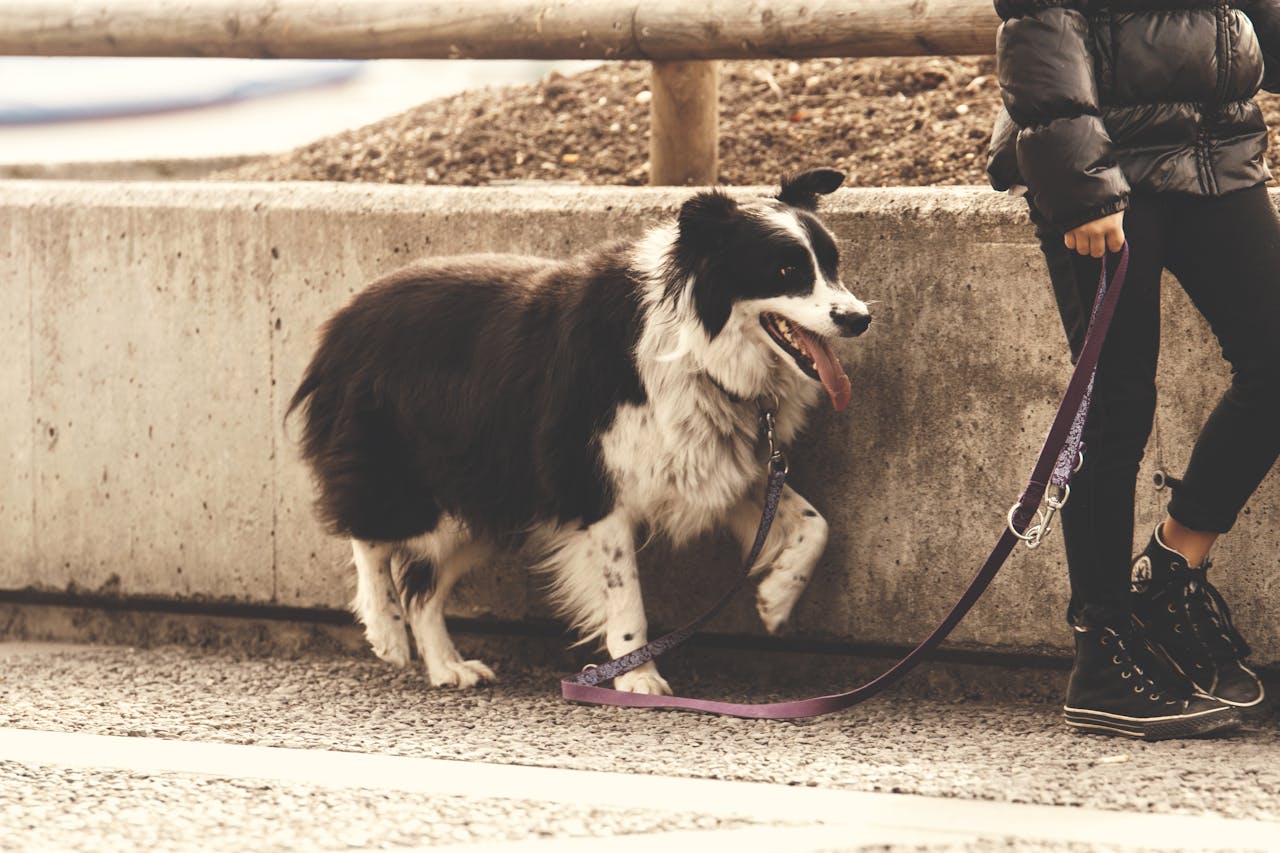

The UK is home to many dog lovers, and the demand for dog walking services has significantly increased. With 28% of UK households owning a dog as of 2024, it’s no surprise that people are exploring how to start a dog walking business.
As modern life becomes increasingly busy, finding time for regular dog walks can be challenging. This has opened up opportunities for individuals to start dog walking businesses, offering flexibility, affordability, and the chance to enjoy working with animals.
This guide outlines the essential steps for starting a successful dog walking business, including financial planning to ensure sustained growth.
Conducting market research: identifying your target audience and competitors
Market research is essential, even for small, local businesses like dog walking. It provides critical insights into potential customers and competitors, guiding business decisions for long-term success.
Market research typically focuses on two areas:
Target Audience
Not all dog owners require a dog walker. The ideal customer is often someone who works full-time and needs support with daily walks. Research should identify where these individuals are located, whether within a small village or a larger urban area. Tools like social media, local papers, and community groups can help identify demand.
Competitors
Understanding competitors in your area is vital. By analysing their services, pricing, and customer base, you can differentiate your business and identify potential gaps in the market.
Leveraging online platforms like Facebook is an excellent way to locate both potential clients and competitors, helping tailor your services effectively.
For example, a quick search of a local town on Facebook resulted in this dog-oriented group:

There’s 511 potential customers for a business in that group alone!
Facebook is not only great for finding your target audience, but also for finding your competitors!
Identifying and Analysing Competitors
Once you’ve located your target audience, it’s crucial to identify who they may already be using for dog walking services. Research local competitors through various channels like newspapers, magazines, town halls, and Facebook groups. Key information to gather includes service areas, pricing, availability, duration of walks, and additional offerings such as boarding or pick-up services.
Conduct thorough research by reviewing their websites, social media pages, and even reaching out directly. Understanding competitors’ strengths and weaknesses will help position your business more competitively.
Identifying and analysing your competitors
Once you’ve located your target audience, it’s crucial to identify who they may already be using for dog walking services. Chances are, if there’s demand for a dog walking service in your community, then someone is already supplying it! Research local competitors through various channels like newspapers, magazines, town halls, and Facebook groups.
If you find any, gather key information like:
- Service areas
- Pricing
- Availability
- Duration of walks
- Additional offerings, such as:
- Boarding
- Pick-up services.
Conduct thorough research by reviewing their websites, social media pages, and even reaching out directly. Understanding competitors’ strengths and weaknesses will help position your business more competitively.
Choosing the right business model for your dog walking service
A business model outlines how a company generates profit, covering key aspects like operations, customer base, and sales strategy. For a small dog walking business, the most common model is direct-to-consumer, where services are provided without intermediaries.
It’s important to evaluate both your expected costs and potential pricing early on. While exact figures may not yet be clear, estimating these will help lay the groundwork for the next steps in building a successful business.
Pricing strategy for dog walking
Your previous market research and competitor analysis should give you some good places to start when deciding on your dog walking business pricing. Lets explore this below:
- Market research: Understand what competitors in your area are charging. For instance, if most dog walkers charge £15 per hour, you might consider setting a competitive rate or offering additional value to justify a higher rate.
- Value proposition: Decide if you want to offer solo walks, group walks, or additional services like boarding or dog sitting. Each service can have different pricing, so tailor your rates based on what you offer.
- Competitive analysis: If you find competitors charging up to £25 for similar services, pricing yourself slightly lower could attract budget-conscious clients. Alternatively, you could charge a premium if you offer something unique, like personalized care or extended walks.
- Cost analysis: Ensure that your pricing covers your costs and allows for a profit. Factor in transportation, insurance, and time spent on walks and other services.
- Niche focus: Consider specialising in a niche market. For example, you might offer specialized services for larger dogs or premium services like individual attention for high-paying clients.
Promoting your dog walking business through effective marketing
The same way you conducted your market research is also the same way you should focus your marketing efforts. Lets explore this further:
Local Promotion:
- Local media: Place ads in local papers or magazines.
- Leaflets and notices: Distribute leaflets or post notices on community boards to reach local pet owners.
Social Media:
- Local groups: Join local Facebook groups or other social media communities where pet owners gather. Engage with members, share your expertise, and build trust.
- Content sharing: Share photos, success stories, and tips about dog care to attract attention and demonstrate your expertise.
Online Presence:
- Website: Create a simple website with information about your services, pricing, and contact details.
- Online Directories: List your business on local online directories or pet-specific platforms.
Word of Mouth:
- Referrals: Encourage satisfied customers to refer you to friends and family.
- Reviews: Ask for reviews on social media or review sites to build credibility.
Starting with a focus on local marketing and leveraging social media can be cost-effective and targeted approaches to building your customer base. As your business grows, you can explore more advanced marketing strategies to expand your reach.
Setting up your dog walking business
Did you know that you need a license for dog walking? Or that it’s best to be first aid trained? Turns out there are quite a few things you need to do before you can start walking someone else’s dog. We will cover these below. As a UK company, we have explored UK laws and registry, but this can be applied across different countries. Make sure to do your own local research.
1. Registering your business
- UK: Register with HMRC as self-employed. Complete a self-assessment tax return annually to pay income tax and national insurance. Keep detailed records of all business expenses and income to avoid overpaying on taxes.
- Other countries: Check local regulations for business registration and tax requirements.
2. Licenses and Certifications
Dog walking license: Not required, but some green spaces may have restrictions. Obtain certifications to enhance your credibility and avoid fines.
Recommended courses: Consider courses for dog walking certification to boost trust and professionalism.
NARPS membership: Joining the National Association of Pet Sitters and Dog Walkers provides benefits like DBS checks, business listings, and discounts on further training.
3. Insurance
Public liability insurance: Essential to cover incidents like dogs getting run over or causing harm. Provides peace of mind for both you and your clients.
4. Legal considerations
Clean Neighbourhoods and Environment Act 2005: Ensure compliance with regulations on dog waste and leash requirements.
Dogs (Protection of Livestock) Act 1953: Prevents dogs from posing a threat to livestock.
GDPR: Protect and manage customer information in compliance with data protection laws.
Running your dog walking business
Now that you’re set-up, insured, and aware of laws and licenses. you might want to reassess how you’ll run your business.
1. Service capacity and specialisations
Dog control: Determine how many dogs you can manage safely and effectively.
Breed restrictions: Decide if you’ll exclude certain breeds based on your experience or capabilities.
Pre-walk assessments: Meet with dog owners beforehand to evaluate suitability and establish trust.
2. Additional services
Dog sitting and boarding: Consider offering these services for additional revenue. They may require extra training or licenses.
Grooming: Adding grooming services can increase your income but may require additional expertise.
3. Pricing and cost analysis
Pricing structure: Assess how many dogs you can walk per session and the associated costs. Ensure your pricing covers all expenses and allows for profit.
Daily revenue goals: Calculate whether your pricing structure meets your financial needs. Consider adding sessions or services to increase revenue.
4. Business management
Daily operations: Plan your schedule to maximize efficiency and manage workloads.
Customer relations: Maintain good communication with clients and provide excellent service to build a strong reputation and secure repeat business.
By carefully considering these factors, you can set up and manage your dog walking business effectively, ensuring compliance, safety, and profitability.
Website and online presence
Creating an effective online presence is crucial for attracting and engaging customers for your dog walking business. Here’s a breakdown of how to leverage different online platforms:
Facebook presence
Advantages:
- Service listings: Easily list and update your services.
- Analytics: Access free insights into page performance and audience engagement.
- Messaging: Communicate directly with potential and current clients.
- Advertising: Cost-effective advertising options to target specific demographics.
- Groups and reviews: Engage with local groups and gather reviews to build trust.
Check out how a local walker has their page set up (for privacy, all personal details are covered):

Setup tips:
- Profile and cover photos: Use high-quality images that reflect your business.
- Service details: Clearly list your services, pricing, and contact information.
- Message pop-up: Implement a message prompt to encourage interactions from visitors.
- See how a local business has done this below:
It is also worth creating an Instagram page:
Instagram presence
Advantages
- Visual appeal: Share photos and videos of happy dogs and your services.
- Engagement: Use Instagram Stories and posts to keep your audience engaged.
- Hashtags: Utilize relevant hashtags to reach a wider audience.
Limitations
- Less networking: Instagram lacks the same networking and group interaction features as Facebook.
- Focus on awareness: Primarily useful for building brand awareness rather than direct client acquisition.
Should you also create a website?
You can should have both a website and social media. However, this can happen over time, as there are some considerations.
When to consider a website?
- Expand reach: If you plan to grow beyond your local area or explore franchise opportunities.
- Improve professionalism: A website provides a more professional appearance and can serve as a central hub for information.
Advantages of a website
- Comprehensive information: Offer detailed information about your services, pricing, and business background.
- SEO: Improve search engine visibility with optimized content.
- Bookings and contact forms: Facilitate easy client interactions and service bookings.
Disadvantages of a website
- Cost and maintenance: Requires investment in domain, hosting, and possibly ongoing maintenance.
- Time and effort: Building and maintaining a website requires time and technical skills.
Final considerations for your online presence:
Make sure to start simple. Focus on creating a strong Facebook presence if you’re starting out and keeping your business local. Then, you can expand over time. Add an Instagram page for additional visibility and consider a website as your business grows.
By effectively utilizing social media platforms and a potential website, you can build a robust online presence that attracts and retains customers.
Funding your dog walking business
Securing adequate funding is often a pivotal factor for startup success. Fortunately, starting a dog walking business is relatively affordable compared to other ventures, typically requiring less than £1000 if you do not need a van.
In most cases, the minimal startup costs for a dog walking business eliminate the need for traditional funding processes, such as seeking investment from banks or investors. The primary expense you might incur would be purchasing a van, especially if you wish to include custom branding.
Investing in a van equipped with crates can be advantageous for safely transporting dogs to their walking destinations. Additionally, having a van can simplify interactions with clients by avoiding the need to bring multiple dogs into their homes.
If acquiring a van becomes necessary, you can manage this through a finance deal at a car dealership or by purchasing a second-hand vehicle, rather than pursuing formal business funding.
The financial plan
Creating a robust financial plan is crucial for the success of any startup. For a dog walking business, this plan will guide you in managing your budget, monitoring cash flow, and planning for growth.
We will explore building this plan in Brixx and breaking it down step by step – you can follow along by signing up.
Section 1: Setting up your plan
Start a new plan in Brixx.
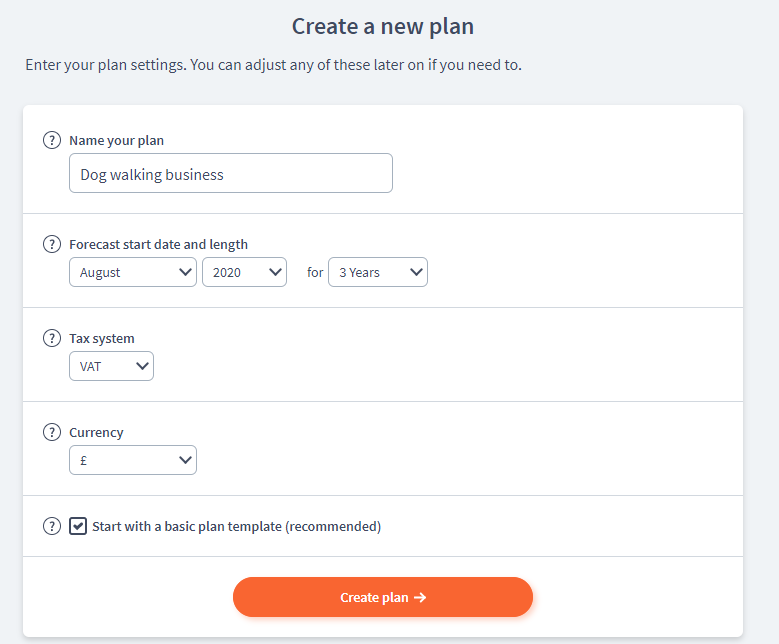
Configure your financial plan in Brixx. Set the plan length to three years, enable VAT (which is necessary), and select GBP (or your own) as your currency. Once these settings are in place, click “Create Plan” to proceed.
Section 2: Income
For a dog walking business, you might offer several services. Here’s how to break down the income from each:
- Group walks: Charge £12 per walk (£10 plus 20% VAT). Initially, you’ll conduct two sessions daily, each with four dogs. For the first three months, you might only have two dogs per walk, yielding £48 per day, five days a week. This results in a weekly income of £240 and 90 units per month (20 x 4.5).
- 1-1 walks: Offered on weekends at £25 per walk. Expect to sell four of these per month initially.
- Dog boarding: Priced at £30 per dog per night, with an expectation of ten bookings per month for the first three months.
Enter these figures into Brixx to track your projected income accurately.
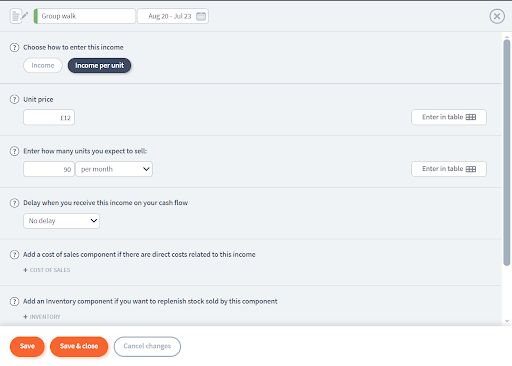
Section 3: Costs of Sales
Costs of sales are directly related to your services. For a dog walking business, these costs are minimal but should be accounted for:
Group and 1-1 walks: The primary cost is petrol for your van. At an average cost of £50 per month, this expense is relatively low.
Dog boarding: Costs include providing food for the dogs at £2 per dog, per night.
In Brixx, add these costs as linked expenses to the respective components of your plan.
This is the income for the first three months.
What happens after the first 3 months?
As business reputation and trustworthiness grows, you might expect your client base to grow too. This means that after the first 3 months, higher capacity can be expected.
You can expand to include:
- 4 dogs on each group walk.
- Two 1-1 walks at the weekends
- 20 dogs boarding, per month.
Go back to your plan and add this growth in.

Section 4: Assets
Tangible assets include items like:
A van for transportation
- Leads
- Bowls
- Crates
- Toys
For example, if you purchase a van for £5000, it will depreciate at 10% per year over five years. Crates and other supplies, costing around £200, are considered miscellaneous items.
Add these assets to your financial plan in Brixx. To manage the upfront cost of the van, consider spreading the expense over three years with a loan, costing £138.89 per month at a 7.5% annual interest rate.
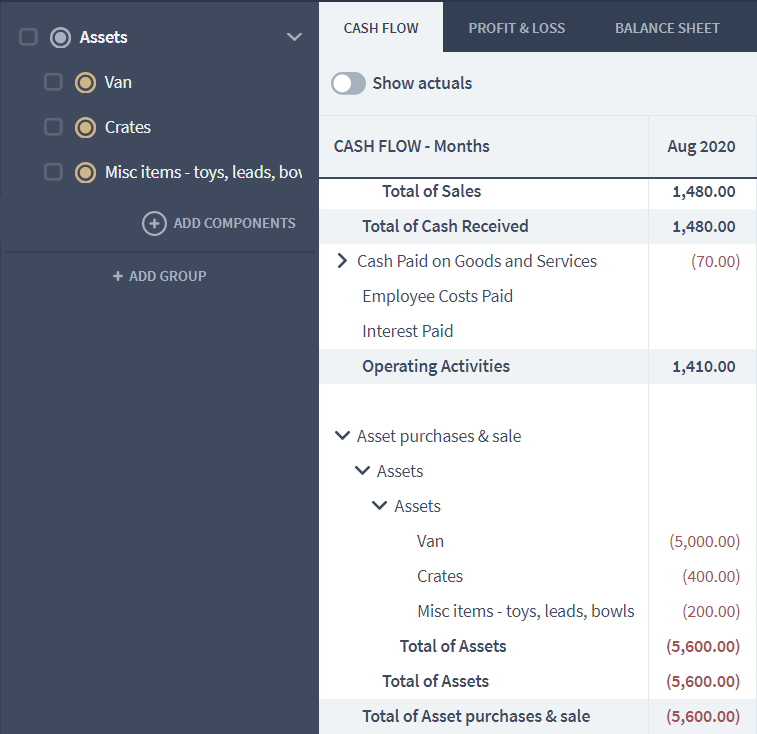
Section 5: Other startup costs
Account for additional expenses such as:
- Insurance: £73.59 annually
- Accreditation: £199 (with NARPS discount)
- NARPS membership: £25
For marketing, budget £50 per month for local print ads and £25 per month for social media campaigns.

Review your Brixx dashboard now to see how you are doing!
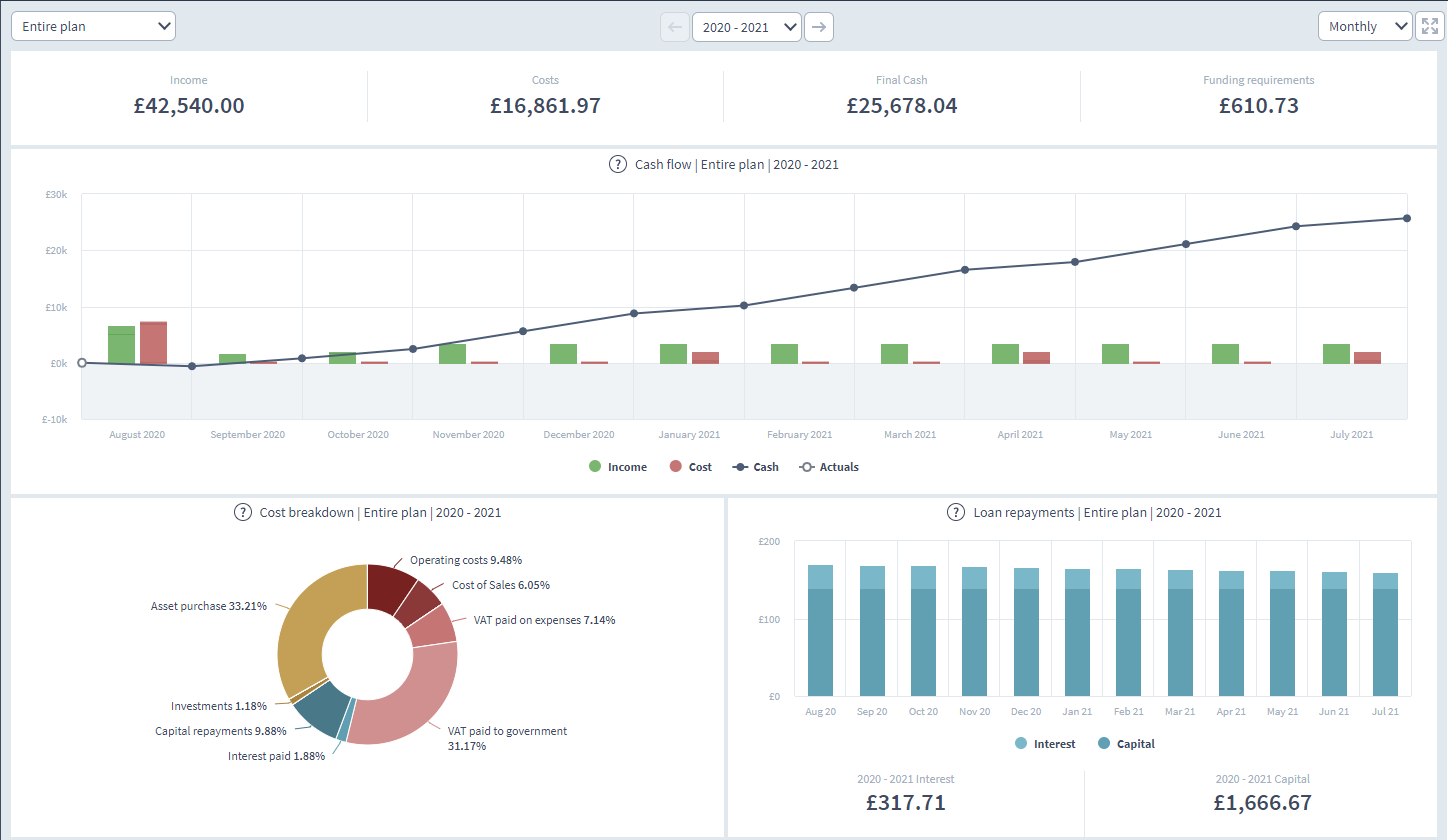
This shows a wealth of information, and it looks like the business will start making a profit by the end of September and grow healthily from there.
Growing and expanding your dog walking business
As your business grows, you may need to adjust your financial plan. For example, expanding to include more dogs or hiring additional staff will impact your revenue and expenses. If you decide to hire an employee to assist with group walks, budget for their wages accordingly.
By the end of 2024, if your business is profitable, you might consider bringing in extra help. Update your plan to reflect these changes, ensuring that your forecasts are realistic and aligned with your growth strategy.
Regularly revisit and update your financial plan to reflect actual performance and adjust for unforeseen changes. This iterative process will help you stay on track and achieve sustainable growth for your dog walking business.

Conclusion
In summary, starting a dog walking business offers a practical and cost-effective entry into entrepreneurship. As demonstrated, the initial setup is relatively straightforward with minimal startup costs, making it an appealing option for many.
While the growth potential of a dog walking business may be somewhat limited, a well-structured financial plan—like the one outlined—can help you achieve a solid and sustainable income.
Utilising tools such as Brixx allows you to model and refine your business planning strategy without the need for credit cards, providing valuable insights and helping you navigate your financial landscape effectively. With careful planning and strategic adjustments, a dog walking business can be both rewarding and profitable.















